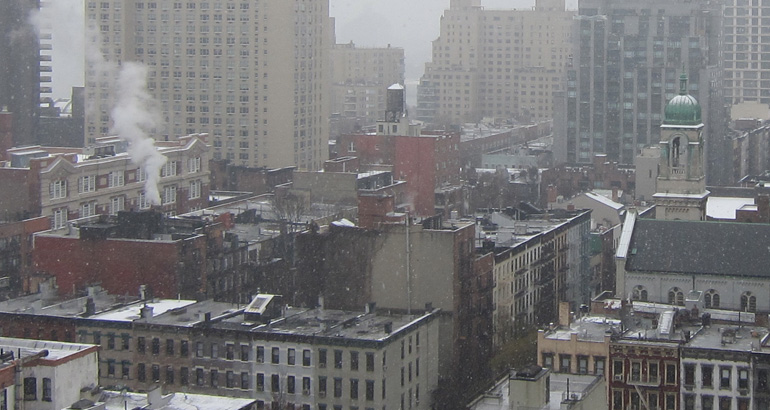Gotham Diary:
Snowy
The city is going white once more, but this time, one expects, without the pileup. Not that we were inconvenienced in the slightest by the post-Christmas dump. It wasn’t until the beginning of this week that I noticed the ramparts of garbage bags that lined most streets. Most of them are gone by now, too.
I woke up with a cold. How serious a cold remains to be sneezed. I was tired all week. Thinking that perhaps I was no longer equal to my holiday bibulousness, I cut back night after night, but to no avail; the mornings, once I was up, I always felt headachy and listless. This malaise would pass during the afternoon. Yesterday afternoon I spent on my feet, alternately preparing dinner and playing with the new shredder.
We have never thought it necessary to keep a shredder at home, but two weeks ago I discovered a pile of fat folders stuffed with all of our monthly billing records from 2000 and 2001, plus credit-card account statements reaching back into the Nineties. Tossing the papers down the chute, with identifying information on every page, seemed rash. So I went over to Staples on Lexington Avenue and bought the cheapest shredder on offer. I bought the cheapest shredder because it was also the smallest; I couldn’t imagine how I would house the ordinary run of units, which ranged from medium wastebasket to clothes hamper in size. The smallest shredder is not the most efficient; its bin has to be emptied constantly, and it quickly overheats. But it will fit in the hall closet in its box (which makes a great temporary wastebasket for the shreds). I don’t expect to use it very often. But I kept it busy all afternoon yesterday — what with all the cooling-down periods.
Trying to decide how to spend the day in bed, I’ve settled on finishing Sarah Bakewell’s How to Live: or, a Life of Montaigne. This was, to my mind, the best book of 2010, and I can’t imagine being a blogger and not finding it of the greatest interest. Montaigne’s textual remains would be far easier to sort out if he had been writing in the digital age; as it is, his Essays would be a vast untraceable palimpsest if had had had a mind to correct what he wrote. Instead, he was happy to add to it, more the doubling the length of his original collection in a bit more than ten years. He left two “final” drafts when he died, and disagreements between them have generated ongoing contentions between proponents of what’s called the “Bordeaux Copy” and of the edition published by Marie de Gournay in 1595. (The recent Pléiade edition, Bakewell tells us, reverts to the long-deprecated 1595 publication.)
Sarah Bakewell’s book is a delight because she tells us how Montaigne wrote, how he lived, and not what he thought. If you want to know what Montaigne thought, there is no reason to read anything but the Essays themselves; and you will do well to avoid simplifying explanations by other hands. Montaigne is an invaluable writer because he captures the ever-shifting appearance of life as we live it; he is not interested in rigorous principles, seeing them for the reductions that they are. As a result, Montaigne does not make sense. His sentences are always intelligible, but his chapters are not; sometimes it is not clear what he is really talking about. Comparing the first edition to the later ones, Bakewell hits on extremely apt imagery.
It filled only two fairly small volumes and, although the “Apology” was already outsized, most chapters remained relatively simple. The often oscillated between rival points of view, but they did not wash around like vast turbulent rivers or fan out into deltas, as later essays did.
Montaigne’s texts may be messy, but they are prodigiously fertile.
Taking breaks from How to Live, I’ve tidied up the apartment from last night’s rout and fixed myself a small sandwich: sliced tenderloin, red onion, and Swiss with mayonnaise on a dinner roll. If I’d bagged the leftover rolls last night, it would be heaven, or at least quite a bit less crumbly. I’m thinking of making a loaf of bread with dinner-roll dough.

